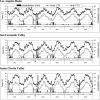West Nile virus emergence and persistence in Los Angeles, California, 2003-2008
- PMID: 20682890
- PMCID: PMC2911193
- DOI: 10.4269/ajtmh.2010.10-0076
West Nile virus emergence and persistence in Los Angeles, California, 2003-2008
Abstract
West Nile virus (WNV) invaded Los Angeles in September 2003, and during the subsequent five-year period followed a pattern of amplification, subsidence, and resurgence. Enzootic transmission was tracked by abundance and infection incidence in Culex pipiens quinquefasciatus and Cx. tarsalis and by seroprevalence in peridomestic passerine birds, infection in dead birds, and seroconversions in sentinel chickens. Culex p. quinquefasciatus served as the primary vector of WNV, with gravid traps serving as the best sampling method and the most consistent indicator of viral activity. Spatial scan statistics applied to mosquito infection and positive dead bird data delimited three major clusters of WNV transmission, with introduction occurring in the Los Angeles Basin, and amplification and dispersal events carrying transmission to the San Fernando and Santa Clarita valleys. Los Angeles experienced major epidemics in 2004 and 2008, providing a unique opportunity to investigate specific patterns of enzootic amplification preceding epidemics.
Figures







References
-
- Wilson J, Hazelrigg JE, Reisen WK, Madon MB. Invasion of Greater Los Angeles by West Nile virus - 2003. Proc Mosq Vector Control Assoc Calif. 2004;72:6–11.
-
- Reeves WC, Asman SM, Hardy JL, Milby MM, Reisen WK. Epidemiology and Control of Mosquito-borne Arboviruses in California, 1943–1987. Proc Mosq Vector Control Assoc Calif. 1990;71:17–27.
-
- Reisen WK, Milby MM, Presser SB, Hardy JL. Ecology of mosquitoes and St. Louis encephalitis virus in the Los Angeles Basin of California, 1987–1990. J Med Entomol. 1992;29:582–598. - PubMed
Publication types
MeSH terms
Grants and funding
LinkOut - more resources
Full Text Sources
Medical

